

Open source projects. Free Small Business Software: 35 Tools For Simplifying Your Business. Management Systems. ERP Systems and Change Management. Communication APIs for SMS, Voice, Video and Authentication. Tim Minchin - Live To Learn. Federal Enterprise Architecture (FEA) Got questions?
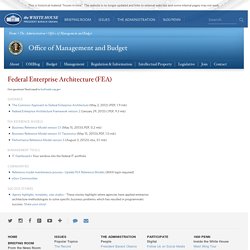
Send email to fea@omb.eop.gov. Free Trial. Free Trial How do I sign up?

If you are eligible, your free trial will start when you sign up for Google Cloud Platform. To sign up, sign in or create a Google Account. You will also need a credit card or bank account details so we can verify your identity. You will not be charged or billed during your free trial. What's included in the free trial? $300 in credit to spend on all Google Cloud Platform products over 60 days.
TurnKey GNU/Linux: 100+ free ready-to-use system images for virtual machines, the cloud, and bare metal. Convincify. Top 10 Technology Trends for 2016. By David W.

Cearley Gartner, Inc. Think of your last 24 hours. Breaking News, U.S., World, Weather, Entertainment & Video News. The cloud changes IT culture, demands new tech skills. As enterprises are moving to the cloud, it's changing a whole lot more than just where companies' data and services are sitting.

The emergence of the cloud is heralding a shift in the skills that IT workers need and the jobs they are doing. It's changing the entire culture inside IT departments. "The cloud is part of the evolution of IT," said Mike Chapple, senior director for IT service delivery at the University of Notre Dame. "People can't be living in one particular technical silo anymore. " The trend is also altering the balance of who is pushing to migrate to the cloud. Sharon Gaudin/Computerworld. Virtualization Made Easy. Free Webinar: SIP Trunking and UCaaS: Two Trends, One Strategy? SIP Trunking and UCaaS: Two Trends, One Strategy?
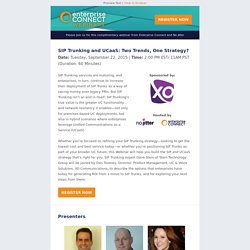
Date: Tuesday, September 22, 2015 | Time: 2:00 PM EST/ 11AM PST (Duration: 60 Minutes) SIP Trunking services are maturing, and enterprises, in turn, continue to increase their deployment of SIP Trunks as a way of saving money over legacy PRIs.
Integration of Enterprise Architecture and Application Portfolio Management. Mike Walker October 2007 Summary: This article describes how application portfolio management (APM) compliments an enterprise architect’s multi-faceted role.
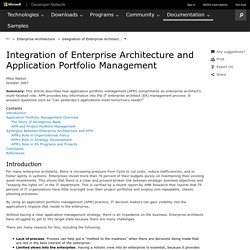
APM provides key information into the IT enterprise architect (EA) management process. It answers questions such as “Can yesterday's applications meet tomorrow's needs?” Contents IntroductionApplication Portfolio Management Overview The Story of Woodgrove Bank APM and Project Portfolio ManagementSynergies Between Enterprise Architecture and APM APM’s Role in Organizational Policy APM’s Role in Strategy Development APM’s Role in EA Programs and ProjectsConclusionReferences. IC589512.jpg (JPEG Image, 876 × 442 pixels) Network cloud. Integration – Standard Best Practices - Enterprise IT Consultant Views on Technologies and Trends. Dec 2 2011 3:12AM GMT Integration – Standard Best Practices There are multiple options available for integrating multiple systems not designed to work together.

The major classifications are Data / Functional / Service Integration with choices on Push vs. Pull, Inbound / Outbound, Synchronous vs. Asynchronous, Online vs. Each form of integration has its own advantages and disadvantages – and there is no silver bullet. While choosing the integration approach, the following are the standard best practices to be considered: Be as non-invasive as possible – try to keep the changes to the existing system to a minimum. Isolate applications so that changes to one application’s internal structures or business logic do not affect other applications. When making updates to another application’s data, make use of that application’s business logic that performs validations and data integrity checks (i.e., at the minimum, use Functional Integration to integrate systems at the logical business layer).
School Public. Jeanne Ross of MIT CISR on Enterprise Architecture. Infrastructure Team Lead Job.
Networking in the cloud. Draft-ietf-6lo-btle-07. Wikispaces. Ask. Answer. Explore. Whenever. NIST drafts guide for hypervisor security. NIST drafts guide for hypervisor security By GCN StaffOct 21, 2014 The National Institute of Standards and Technology released a draft of SP-800-125 A, Security Recommendations for Hypervisor Deployment, for public comment.
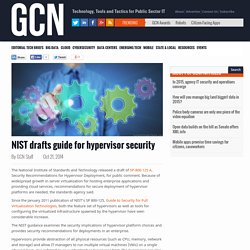
Because of widespread growth in server virtualization for hosting enterprise applications and providing cloud services, recommendations for secure deployment of hypervisor platforms are needed, the standards agency said. Since the January 2011 publication of NIST’s SP 800-125, Guide to Security for Full Virtualization Technologies, both the feature set of hypervisors as well as tools for configuring the virtualized infrastructure spawned by the hypervisor have seen considerable increase. The NIST guidance examines the security implications of hypervisor platform choices and provides security recommendations for deployments in an enterprise.
The security recommendations on baseline functions refer to configuration choices that ensure the secure execution of tasks. Lucid Chart. Openstack, AWS, HyperV, VMware. Who Uses These Cloud and Virtualization Systems?

OpenStack, AWS, Hyper-V and VMware are different services offering cloud computing or virtualization services. Let's take a closer look to see the advantages of each, as well as look at some companies using them. OpenStack OpenStack provides Infrastructure-as-a-Service (IaaS). It is a fast growing cloud computing project used by small and large companies alike. OpenStack is a cloud operating system consisting of several projects.
Microsoft. Openstack. Cisco network foundation design profile. IBM. HP Cloud. Cloud. The Importance of Context Sensitivity in a Multimodal World. Enterprise resource planning (ERP) is the integration of critical business functions into a single end-to-end process.
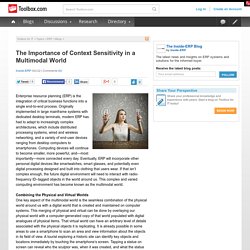
Originally implemented in large mainframe systems with dedicated desktop terminals, modern ERP has had to adapt to increasingly complex architectures, which include distributed processing systems, wired and wireless networking, and a variety of end-user devices ranging from desktop computers to smartphones. Computing devices will continue to become smaller, more powerful, and—most importantly—more connected every day. Eventually, ERP will incorporate other personal digital devices like smartwatches, smart glasses, and potentially even digital processing designed and built into clothing that users wear.
If that isn’t complex enough, the future digital environment will need to interact with radio-frequency ID–tagged objects in the world around us. This complex and varied computing environment has become known as the multimodal world. Context Sensitivity is the Key. Guides - Google Apps setup.
Waypoints. PoC. Connections. Technology infrastructure initial design.